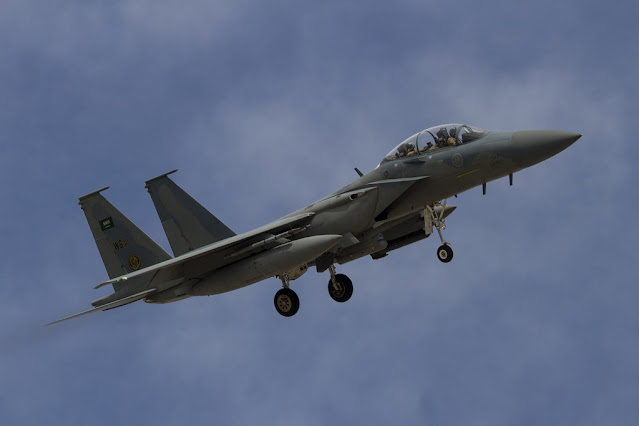Report: Red Flag-Nellis 22-2
 |
| Royal Saudi Air Force F-15SA lands at Nellis Air Base at the end of a Red Flag 22-2 mission. |
Red Flag was established on Nov. 29, 1975 and has been at the forefront of the Air Force drive to dominate the enemy in air combat operations. It opened the pathway to a radically new type of fighter training and helped to forge the professional Air Force that today sets the world standard. It also changed the thinking of airmen around the world, including those in adversary air forces, and it has influenced the training of the US Army and Navy air arms.
Red Flag, which was developed to help the Air Force “to train as it fights”, is a simulated combat training exercise under a war scenario that pulls in the air forces of the United States and allies. A typical Red Flag exercise involves a wide variety of aircraft. Thorough mission debriefings are based on the Red Flag Measurement and Debriefing System along with TV ordnance scoring and threat video. Participants can replay the mission and learn exactly what was done correctly and what needs work.
Over a quarter century, Red Flag has become one of the greatest of Air Force success stories. Like many successes, Red Flag can trace its roots to an earlier failure which came in Southeast Asia in the 1960s during the Vietnam War where the kill ration of the US fighters dropped from 10-1 (which had achieved during the Korean War) to 1-1 and sometimes even less...
Red Flag, which was developed to help the Air Force “to train as it fights”, is a simulated combat training exercise under a war scenario that pulls in the air forces of the United States and allies. A typical Red Flag exercise involves a wide variety of aircraft. Thorough mission debriefings are based on the Red Flag Measurement and Debriefing System along with TV ordnance scoring and threat video. Participants can replay the mission and learn exactly what was done correctly and what needs work.
Over a quarter century, Red Flag has become one of the greatest of Air Force success stories. Like many successes, Red Flag can trace its roots to an earlier failure which came in Southeast Asia in the 1960s during the Vietnam War where the kill ration of the US fighters dropped from 10-1 (which had achieved during the Korean War) to 1-1 and sometimes even less...
Aggressors:
Many would argue that the “birth” of the Red Flag was highly related with the establishment of the first Aggressor Squadron. One important event that initiated this establishment was the transformation of the 4520th Combat Crew Training Wing at Nellis into the Tactical Fighter Weapons Center, under the leadership of Maj. Gen. R.G. “Zack” Taylor. Taylor saw that the huge area surrounding Nellis would be ideal for an aerial training range of mammoth proportions, ultimately reaching 12,000 square miles.
The initial idea was that fighter squadrons would rotate through Nellis to train with the aggressors and that the aggressors would go out to “visit” squadrons in the field. It was equipped initially with T-38s and then with Northrop F-5E Tiger aircraft. These small supersonic aircraft were used to simulate the MiG-21 in air combat maneuvers. The resulting exercises were deemed to be so useful that the Air Force fashioned a second squadron-the 65th FWS at Nellis and two more for overseas training.
The first actual Red Flag featured participation by 37 aircraft, shepherded by 561 people. Some 552 sorties were flown. The effort was small compared to later efforts.
Though small, the first Red Flag was an unqualified success. Initially oriented primarily to air-to-surface training, Red Flag had from the start a substantial air-to-air component and this would grow over time. Other US services joined in, as did units from around the world. Red Flag grew in size and sophistication. Today’s Red Flag over a single year will involve as many as 250 different units and 500 aircraft of many different types. About 11,000 aircrew and squadron personnel will amass more than 12,000 sorties and 21,000 flight hours in the course of the year.
One major milestone in that history, without question, was the stunning performance of American airmen in the Gulf War of 1991. It was the first war to showcase the results of Red Flag, and it produced a curious tribute. It came from an Air Force pilot who, returning from a combat mission over Iraq, was heard to remark, “It was almost as intense as Red Flag.”
Report by George Karavantos



















No comments
All comments related to the contents of our articles are welcome. It is not allowed to post promotional messages, links to external sites, or references to activities not related to this blog.